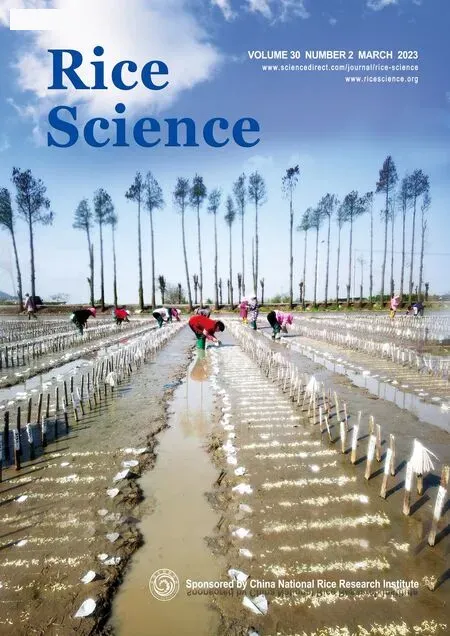Antioxidant Activities and Characterization of Polyphenols from Selected Northern Thai Rice Husks: Relation with Seed Attributes
2023-02-20JiratchayaWISETKOMOLMATChaiwatARJINSuratHONGSIBSONGWarintornRUKSIRIWANICHChutamatNIWATPimsiriTIYAYONSansaneeJAMJODSupapohnYAMUANGMORNChanakanPROMTHAIKorawanSRINGARM
Jiratchaya WISETKOMOLMAT ,Chaiwat ARJIN ,Surat HONGSIBSONG ,Warintorn RUKSIRIWANICH ,Chutamat NIWAT ,Pimsiri TIYAYON,Sansanee JAMJOD,Supapohn YAMUANGMORN,Chanakan PROM-U-THAI,,Korawan SRINGARM,,
(1Department of Animal and Aquatic Sciences,Faculty of Agriculture,Chiang Mai University,Chiang Mai 50200,Thailand;2School of Health Science Research,Research Institute for Health Sciences,Chiang Mai University,Chiang Mai 50200,Thailand;3Department of Pharmaceutical Sciences,Faculty of Pharmacy,Chiang Mai University,Chiang Mai 50200,Thailand;4Food Science and Technology Program,School of Agro-Industry,Mae Fah Luang University,Chiang Rai 57100,Thailand;5School of Agricultural Resources,Chulalongkorn University,Bangkok 10330,Thailand;6Agronomy Division,Department of Plant and Soil Sciences,Faculty of Agriculture,Chiang Mai University,Chiang Mai 50200,Thailand;7Lanna Rice Research Center,Chiang Mai University,Chiang Mai 50200,Thailand;8Cluster of Research and Development of Pharmaceutical and Natural Products Innovation for Human or Animal,Chiang Mai University,Chiang Mai 50200,Thailand)
Abstract: Rice production generates a significant amount of agricultural waste.This study aimed to give results related to the existence of antioxidant phenols in agricultural waste of selected Northern Thai rice varieties.The antioxidant activities,contents of total flavonoids and phenolic compounds in the ethanolic rice husk extract were evaluated.The highest antioxidant activities were found in the variety PES1CMU,with 2,2'-azinobis-3-ethyl-benzothiazoline-6-sulfonic acid and 2,2-diphenyl-1-picrylhydrazyl as 679.66 and 4.16 mmol/(L·g) trolox equivalent,respectively,ferric reducing antioxidant power as 0.87 mmol/(L·g) Fe2+,total phenolic content as 29.90 mmol/(L·g) gallic acid and total flavonoid content as 12.16 mg/g catechin equivalent.Polyphenol compounds were identified mainly by standard polyphenols using the liquid chromatography mass spectrometry,with the highest contents of phytic acid,o-coumaric acid,naringin and kaempferol.The non-glutenous and wetland ecotypes of rice husk samples were the richest in antioxidant activities and polyphenol contents characterized by using principal component analysis.The glutenous rice husk contained higher antioxidant activities than the rest.Interestingly,quercetin is a significant phenolic compound that positively correlated with the overall antioxidant activities of rice husk.This finding will be relevant for future application of rice husk antioxidant components in the production of functional ingredients as well as for the food and pharmaceutical industries.
Key words: antioxidant;agri-waste;polyphenol;rice husk;seed characteristic;Thai rice
Rice (Oryza sativaL.) is the primary source of food for more than half of the world’s population,mainly in Asia (Asadi et al,2021;Yamuangmorn and Prom-UThai,2021) because of the quality and quantity of the nutrients and the different forms to the consumer(Korres et al,2017;do Nascimento et al,2022).In Thailand,more than 5 000 varieties of rice are known to exist in the country,and rice cultivation accounts for 66% of the country’s agricultural acreage (Jamjod et al,2017;Taratima et al,2019).
Rice production for human consumption generates a significant volume of waste products each year (Zhang et al,2010).In the commercial rice milling process,the first step is to remove the husk and release the whole grain (brown rice),which is made up of the endosperm(white rice) and the bran layer (Chatha et al,2011;Goufo and Trindade,2017).For rice grains,approximately 70% is the endosperm,10% is bran,and 20% is husk(Nenadis et al,2013;Irakli et al,2018;Park et al,2019;Zaky et al,2022).Rice husk is made up of lignin (22%),cellulose (38%),hemicellulose (18%),extractive (2%)and ash (20%) on average,but its chemical composition varies depending on geographic area,climatic conditions,soil composition and others (Chandrasekhar et al,2003;Salanti et al,2010).But for consumption,rice husk has low nutritional and economic values (Lee et al,2003;Butsat and Siriamornpun,2010;Salanti et al,2010;Sankam et al,2013;Irakli et al,2018).Additionally,the whole rice seed contains more fibre,resistant starch,protein and lipid than polished rice,which is mostly carbohydrate with some protein fractions.Some coloured rice cultivars also include antioxidant-active chemicals that are high in nutrition values (do Nascimento et al,2022).
In recent years,evidence has accumulated indicating a diet rich in ‘relatively high’ natural antioxidants such as polyphenols and flavonoids from plants.These bioactive compounds exhibit the properties which can reduce the prevalence of degenerative diseases such as cancer,cardiovascular disease and aging (Wu et al,2004;Ed Nignpense et al,2021).Nutritionists are increasingly interested in finding antioxidants that are both safe and natural,and a varied set of plant substances known as natural antioxidants has been the focus of significant research in this area (Young and Woodside,2001;Wu et al,2004;Dimitrios,2006;Sultana et al,2008).In line with the overall trend of using agro-industrial wastes as ‘raw materials’ for the recovery of useful compounds (Dimitrios,2006;Peschel et al,2006;Nenadis et al,2013),agricultural by-products are being investigated as potential natural antioxidant sources (Moure et al,2001;Lee et al,2003;Sultana et al,2008).However,more research into prospective sources and optimization of extraction procedures is still needed to understandin vivoaction(Moure et al,2001).
The health advantages of rice husk components,by-products of rice processing,have been reported.Rice husks contain bioactive compounds such as phenolic acids,flavonoids,tocopherols and polysaccharides,with these phytochemicals exhibiting biological activities (Butsat and Siriamornpun,2010;Park et al,2019;Verma and Srivastav,2020;Khantham et al,2022).As a result,rice husks are seen as a cost-effective source of natural antioxidants,prompting a flurry of research into their molecular processes of protection against oxidative stress (Butsat and Siriamornpun,2010;Ramakrishna et al,2021).
Generally,few reports focus on the relationship between the characteristics of rice husk and antioxidant characteristics.Hence,the objective of this study was to investigate the presence of antioxidant phenols in Northern Thai rice husks.The research outcome will be relevant for future research and application of rice husk antioxidant components in the production of functional ingredients as well as for food and pharmaceutical industry or the potential for applications in the promotion of health and prevention of radical damage.
RESULTS
Yield of crude extract
Fig.1 showed the performances of 12 rice husk samples from the Lanna Rice Research Center,Chiang Mai University,Chiang Mai,Thailand.The yield of crude ethanolic extract in rice husk is shown in Table 1.The highest yield was found in the sample of KAK1CMU (2.50%),followed by PES1CMU and RD6 (2.44% and 2.25%,respectively).

Table 1.Rice varieties with special grain quality.
Evaluation of antioxidant activities
There were significant differences (P< 0.05) in antioxidant activities among the rice husk samples(Table 2).2,2'-azinobis-3-ethyl-benzothiazoline-6-sulfonic acid (ABTS) was significantly different among all rice husk extracts.Overall,the highest of ABTS was found in the extract of PES1CMU [679.66 mmol/(L·g) trolox equivalent (TE)],followed by Sang5CMU and K4CMU [546.04 and 515.79 mmol/(L·g) TE,respectively].The highest content of 2,2-diphenyl-1-picrylhydrazyl (DPPH) was detected in K4CMU [4.81 mmol/(L·g) TE],followed by BB3CMU and PES1CMU[4.39 and 4.16 mmol/(L·g) TE,respectively].Among the samples,the husk extract of PES1CMU showed the highest Ferric reducing antioxidant power (FRAP)content [0.87 mmol/(L·g) Fe2+],followed by KAK1CMU,K4CMU and KDK [0.63,0.60 and 0.60 mmol/(L·g) Fe2+,respectively].
Total phenolic and flavonoid compound contents
The highest content of total phenolic compound was observed in the sample of PES1CMU (29.90 mg/g GE),followed by K4CMU and KDK (21.90 and 20.79 mg/g GE,respectively) (Table 3).The lowest content was found in BKU5CMU (10.63 mg/g GE).The highest content of total flavonoid was detected in the sample of PES1CMU (12.16 mg/g CE),followed by KAK1CMU and K4CMU (9.04 and 8.37 mg/g CE,respectively).The lowest content was found in KCCMU107 (3.29 mg/g CE).
Relationship between seed attributes and antioxidant activities
The relationship between antioxidant activities in the rice husk samples was evaluated using principal component analysis (PCA) based on the parameters of seed characteristics,including pericarp color,husk color,ecotype and endosperm type.The first principal component (PC1) accounted for 85.4% and the second principal component (PC2) accounted for 9.9% of the total variation in the results.The eigen values for the first four PCs are reported in Table 3.The score plots of antioxidant activities,total phenolic and total flavonoid contents were shown in Fig.2-A.Two distinct groups were formed,which were separated by an endospermtype (Fig.2-B).The group of glutinous rice is located in the first-fourth quadrant,and it contains the varieties Sang5CMU,PES1CMU,BKU5CMU and KAK1CMU.In addition,the group of non-glutinous rice is clumped in the second-third quadrant according to their antioxidant activities,total phenolic and total flavonoid contents.The results indicate that each group of rice has different antioxidant activities,phenolic and flavonoid characteristics,whereas other seed attributes did not clearly explained the relationship (Fig.2-C and-D).

Table 2.Antioxidant activities,total phenolic and total flavonoid contents of rice husk extracts.

Table 3.Eigen analysis of the loadings of significant principal components (PCs) for antioxidants,total phenolic,and total flavonoid contents in rice husk samples.
Based on the PCA analysis (Fig.2),the mean of antioxidant activities was compared between the groups of glutenous and non-glutenous rice husks.Inthis context,the overall antioxidant activities of glutenous rice husk samples were higher than those of other glutenous samples.The result of PCA was supported by the correlation of each antioxidant activity (Table 4).There was a high correlation between total phenolic content and FRAP,followed by a correlation between total phenolic content and total flavonoid content.However,there was a low correlation between the parameters measured for antioxidant activities,DPPH and ABTS of samples.

Table 4.Pearson correlation analysis of antioxidants,total phenolic,and total flavonoid contents in rice husks categorized by endosperm type.
Characteristics of phenolic compounds
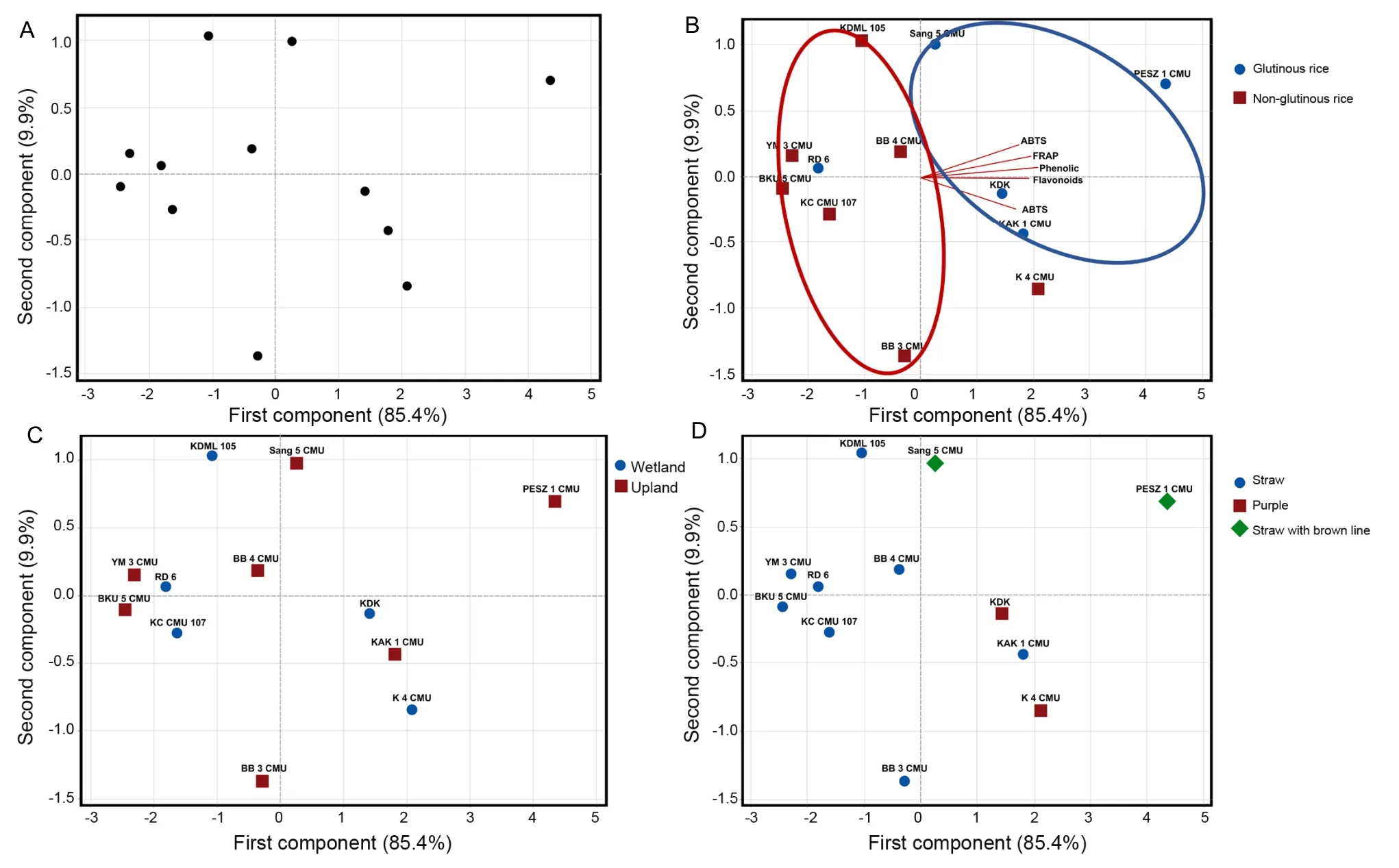
Fig.2.Principle component analysis (PCA) of antioxidant activity,total phenolic content,and total flavonoid contents in rice husk.
The content of each polyphenolic compound in different varieties of rice husk samples is summarized in Table 5.Seventeen compounds were identified by comparison of their mass spectra and retention times of standards available in the laboratory.The highest content of phenol which was detected in rice husk samples is phytic acid (5.44-118.05 mg/g),followed byo-coumaric (0.37-2.81 mg/g),naringin (0.04-7.89 mg/g but not detected in BKU5CMU and PES1CMU),and kaempferol (0.13-3.63 mg/g).
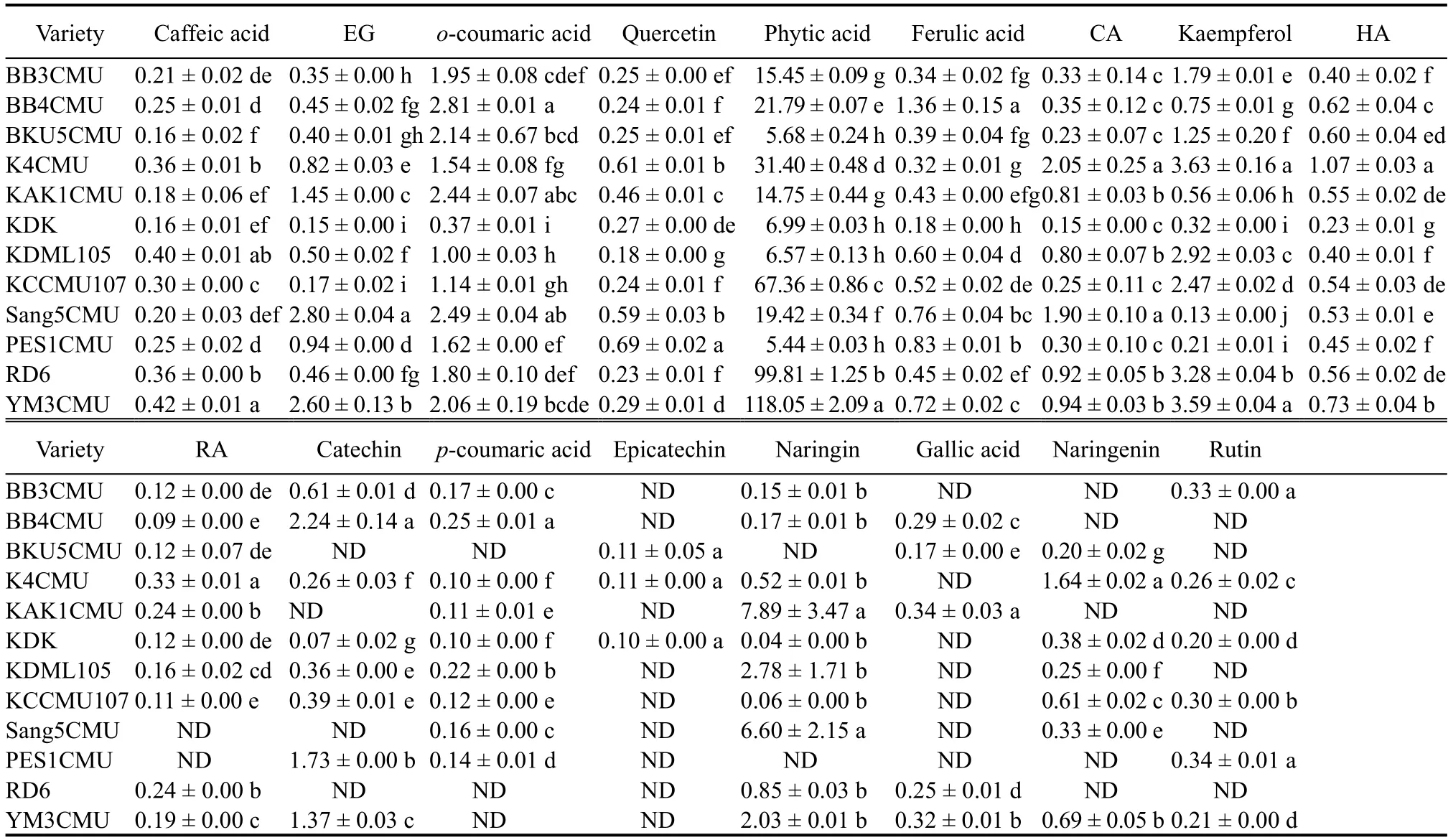
Table 5.Phenolic contents in different varieties of rice husk. mg/g
Relationship between seed attributes and polyphenols
The relationship between the polyphenol profile in the rice husk samples was evaluated using PCA based on the parameters of each sample,including pericarp color,husk color,ecotype and endosperm type.Two principal components explained a total of 46.0% of the variation(Fig.3).PC1 accounted for 26.0% and PC2 accounted for 21.0% of the total variation in the results.Fig.3-B shows two distinct groups of samples labeled by an ecotype characteristic.The group of wetland ecotypes is located in the first-second quadrant and related to the variable of caffeic acid,rosmarinic acid,kaempferol and naringenin.Besides,the group of upland ecotypes is located in the third-forth quadrant according to the parameter of catechin,o-coumaric,ferulic acid and epigallocatechin gallate.
The correlation between the antioxidant activities and polyphenol compound content in rice husk varieties categorized by ecotype was investigated to explain the PCA result in Fig.3-B.Firstly,we found no relation between the parameter of total phenolic content and the ecotype of the sample (Fig.3-C).After polyphenol compounds were identified,the relationship between the level of antioxidant activities and each phenolic compound content was then determined.The result was the same trend as the previous section,and there had no relationship between each phenolic compound’s content and antioxidant activities.For example,the samples (such as PES1CMU) having a high content of phytic acid were found to have a lower capacity of antioxidants than the samples (such as YM3CMU) containing the lowest content of phytic acid.However,only quercetin was accepted as circumstantial.There was a strong positive correlationbetween quercetin and antioxidant activity overall.
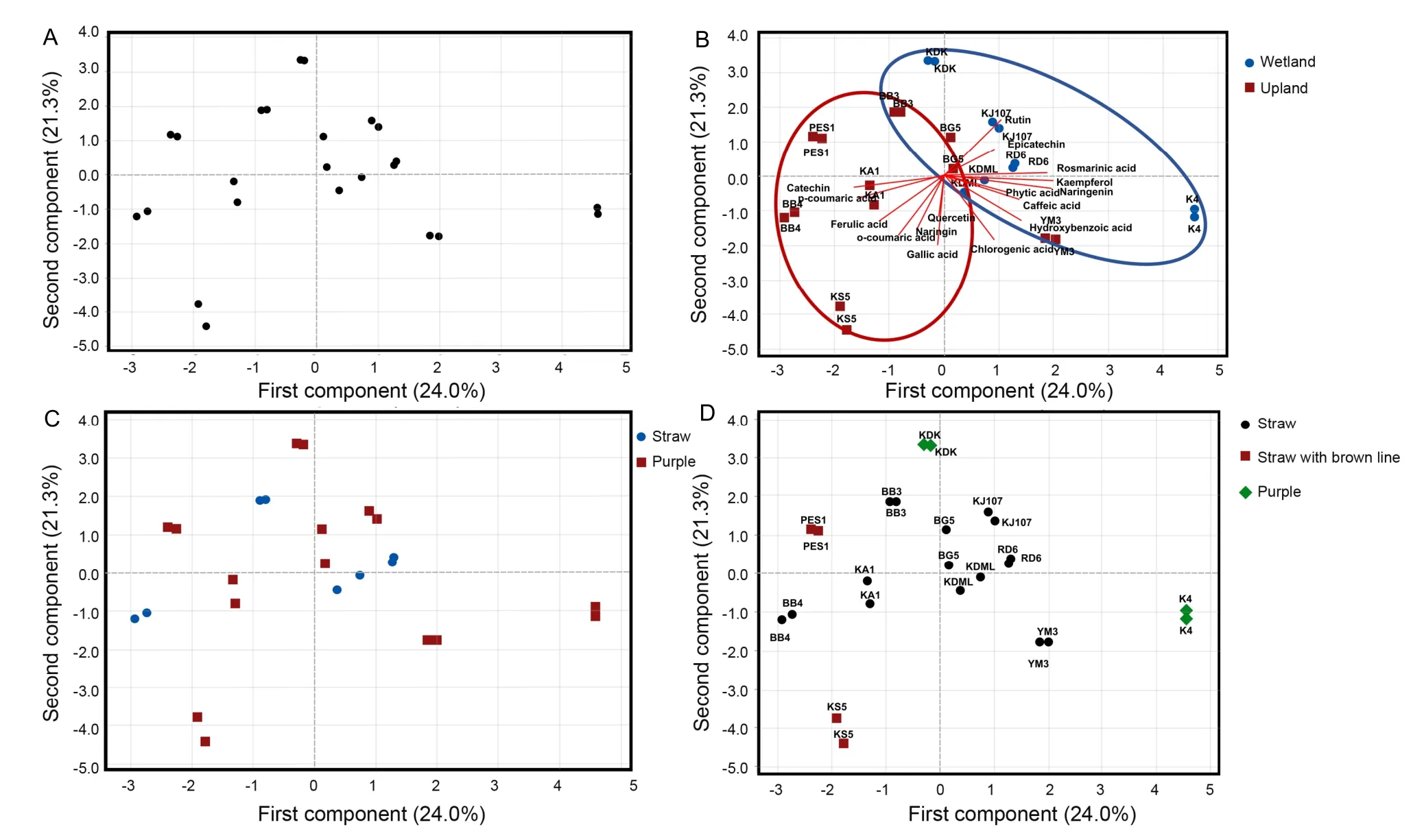
Fig.3.Principle component analysis (PCA) of polyphenolic profile in rice husk samples.
Furthermore,to explain specific polyphenol characteristics of the rice husk sample,the relationship between ecotype and phenolic compound was investigated (Fig.4).The Pearson’s correlation suggested that wetland ecotypes were associated with phenol compounds of caffeic acid,rosmarinic acid,naringenin and kaempferol.Additionally,an upland ecotype was associated with phenol compounds of catechin,epigallocatechin gallate,o-coumaric and ferulic acid.However,there was a low correlation between other phenol compounds measured.
DISCUSSION
In this study,we determined the content of antioxidant compounds contained in various varieties of highquality Lanna Thai rice husks and its relationship between the seed attributes and antioxidant activities.Among the circular economy solutions,one of the most promising is the conversion of waste into highcommercial-value commodities such as medicines,nutraceuticals and cosmeceuticals (Peschel et al,2006).Likewise,rice husk is a non-edible plant component with limited economic value (Sankam et al,2013).They were normally employed in a variety of non-food applications,such as low-value waste products (Salanti et al,2010;Pfaltzgraff et al,2013;Murtey and Seeni,2020).Several studies suggested that strong antioxidants have been found in rice husks.Consequently,rice husk can be a good source of natural antioxidant candidates(Lee et al,2003;Sankam et al,2013).
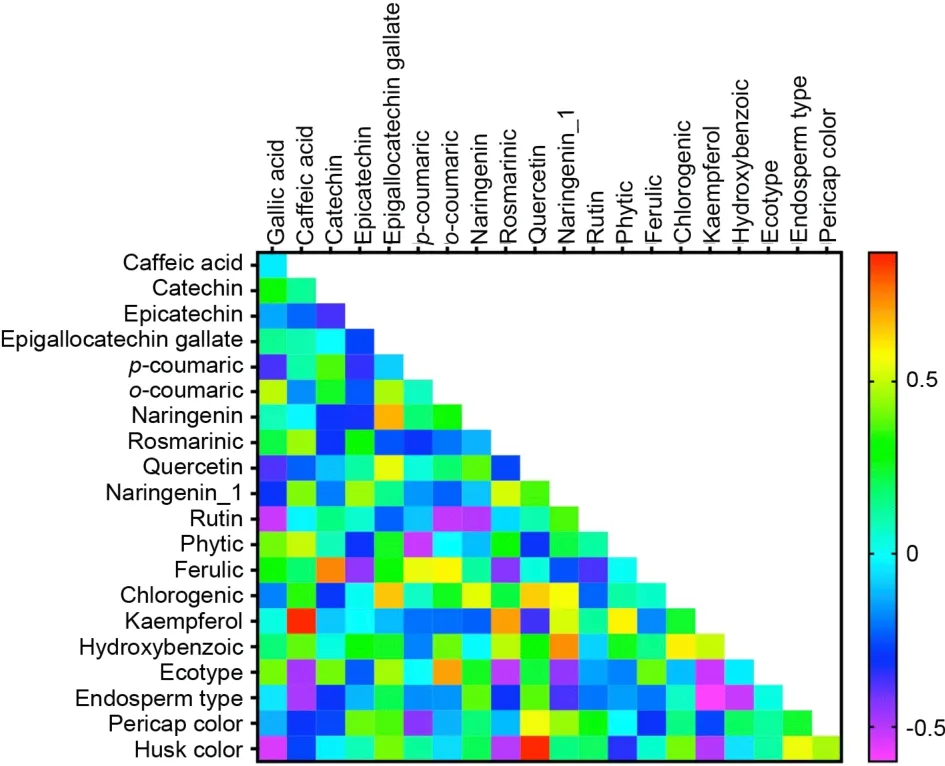
Fig.4.Pearson correlations among all characters of rice seed attribute and polyphenol compound.
In this prospect,several techniques have been used to assess thein vitroantioxidant capability of various plant materials.Because different methodologies use different reaction mechanisms,the results achieved are also dependent on the methodology used.As a result,it is advised that at least two methods will be used to determine the sample’s antioxidant capacity (Pérez-Jiménez et al,2008).In order to provide such data,the antioxidant contents in our report were analyzed by ABTS,DPPH and FRAP assays,and the contents of total phenolics and total flavonoids were also investigated by using colorimetry method.
Evaluation of antioxidant activities of rice husk extract and their relations with seed attributes
The antioxidant activities of rice husk extracts showed significant variability in the studied samples (P≤ 0.05).Overall,the highest content of antioxidants was found in the ethanolic extract of PES1CMU (glutinous rice,pericarp with purple color,straw with brown line husk color),followed by K4CMU (non-glutinous rice,pericarp with purple color,purple husk color),KDK(glutinous rice,pericarp with purple color,purple husk color),and KCCMU107 (non-glutinous rice,pericarp with purple color,straw husk color).A similar trend was found in the total content of phenolics and flavonoids.Goufo and Trindade (2014) found the variation in the content of the antioxidant activity of colored and non-colored rice husks which showed the high content of phenolic acid in pigmented rice varieties.In line with those results,several reports agree that there is substantial evidence to support the assumption that pigmented rice varieties contain more phenolic acid than non-pigmented ones (Goffman and Bergman,2004;Vichapong et al,2010).Not only phenolic acid,but also flavone compounds are the most typically found flavonoids in non-pigmented rice cultivars (Goufo and Trindade,2014).
Based on the results of Wisetkomolmat et al (2022),we investigated the relationship between rice bran characteristics and their chemical profiles,and PCA was used to group rice into three main groups with different characteristics of rice seed,contrasted with Goufo and Trindade (2014) in which the rice sample was categorized by its bran color into four groups viz.brown,black,purple and red.Pigmented rice refers to rice with black,purple and red bran,whereas non-pigmented rice refers to rice with brown bran.In this report,we categorized the characteristics of a rice grain into four major attributes,including pericarp color,husk color,endosperm type and ecotype.The results of PCA analysis of the relationship between rice grain characteristics (pericarp color,husk color,endosperm type and ecotype) and antioxidant content showed that only endosperm type can be grouped into the antioxidant activity profiles (Fig.2).This result also indicated that the group of glutinous rice husk samples contained a higher content of antioxidants than non-glutinous rice husk samples,but there was no significant difference atP< 0.05.
The variation in the antioxidant potential of compounds depends on the type and polarity of the extracting solvent,the concentration of the extract,the isolation technique,and the purity of the active compound (Moure et al,2001;Hussain et al,2012).The genetic makeup of different rice varieties,preharvest factors,storage conditions and analytical methodologies are also the key reasons responsible for the wide range of the values in the literature (Khantham et al,2021;do Nascimento et al,2022).Moreover,the effects of processing procedures on plant bioactive components could range from no change to significant losses,or even an increase in bioactive chemicals and antioxidant capabilities (Wanyo et al,2014).
Polyphenol compounds of Thai rice husk
Polyphenol compounds are the most active antioxidant derivatives in plants,which are typically found in the outer layers of plants containing vast levels of phenolic compounds to protect the inside components (Bors et al,2001).In the outer layer,various cell wall components,such as arabinoxylans and proteins,are connected to phenolic acids (Bunzel,2010).They are well-known natural antioxidants for their propensity to donate hydrogen or electrons,as well as for being stable radical intermediates (Ed Nignpense et al,2021).Likewise,phenolic chemicals are abundant in fruits and vegetables,and they have gained considerable interest due to their antioxidant properties and free-radical scavenging abilities,which have the potential to be beneficial to human health (Dimitrios,2006;Wanyo et al,2014;Ed Nignpense et al,2021).Because of the complexities of their chemical nature and their presence in plant materials,plant phenols have not been thoroughly researched (Dimitrios,2006).
Bioactive compounds like phenols have a wide spectrum of pharmacological effects,making them attractive constituents for nutraceutical applications(Peschel et al,2006).Phenols must reach the target tissue in order to exert their positive bioactivities on human health (Dimitrios,2006).According to scientific research,enhancing the bioaccessibility of dietary phenols is one of the most important aspects of maximizing these molecules’ bioactive characteristics(Zaky et al,2022).
For the study of phenolic compounds in rice grain,Goffman and Bergman (2004) found that phenolics in rice appear to be associated with bran color,with light-brown bran genotypes having the lowest phenolic levels and anti-radical efficiency,while red bran genotypes have ten times greater total phenolic content than light-brown ones.The antioxidant activity of phenolic acids is shown to be stronger than that of anthocyanins (Goufo and Trindade,2014).Butsat and Siriamornpun (2010) revealed that rather than total phenolic content,the antioxidant activity of husks may be due to the composition of phenolic molecules.Moreover,the enzymatic breakdown of the rice endosperm cell wall yielded many phenolic carbohydrate esters,including ferulic acid esters of arabinoxylan fragments and diferulic acid (Lee et al,2003).Several of these phytochemicals,such as ferulic acid and diferulates,are found mostly in grains,but not in substantial amounts in some fruits and vegetables(Adom and Liu,2002).
The phenolic compounds contained in the grain sample can be detected in free,soluble conjugate and insoluble bound forms.Approximately 74% of total phenolics in rice are in insoluble bound forms (Adom and Liu,2002).Thammapat et al (2016) found different compositions of free and bound phenolics in their rice samples.The highest phenolic acid compounds found in rice were protocatechuic,gallic,ferulic andp-coumaric acids.Likewise,Park et al (2019) reported that the most dominant phenolic compounds present in rice husk samples werep-coumaric,vanillic and ferulic acids.In this context,ferulic acid can be found in various kinds of fruits,vegetables and cereals.Ferulic acid is esterified to cell wall components in rice (Adom and Liu,2002;Thammapat et al,2016) and thus becomes part of the dietary fibre,where it exists in an insoluble bound state (Arranz et al,2010).Ferulic acid is one of the most significant phenolic acids,with anti-inflammatory,anti-atherogenic,anti-diabetic,anti-aging,neuroprotective,radioprotective and hepatoprotective activities (Wang et al,2015).Because of these qualities,it is gaining popularity in the food,health,cosmetics and pharmaceutical industries.
Both variations of polyphenol content and compounds were identified in our rice husk samples.Phytic acid was the most abundant polyphenol compound found in the sample,followed byo-coumaric acid,naringin and kaempferol,but contrasted with other previous reports(Thammapat et al,2016;Park et al,2019).In rice grains,phytic acid is the primary phosphorus storage form,with a range of 0.6%-1.1% in brown rice (Frank et al,2007).Phytic acid has been considered antinutritional since it decreases the bioavailability of certain minerals that are essential for human nutrition(Canan et al,2011).However,phytic acid has been scientifically researched for its positive effect on human health in the prevention of some diseases such as Parkinson’s disease (Xu et al,2008) and diabete(Lee et al,2006).
Based on the PCA results (Figs.2 and 3),when focusing on the parameter of ecotype,there was no correlation with total phenolic content.However,there was a variation in relation to each compound and sample.For example,phytic in wetland ecotype was higher than that in upland ecotype,while in wetland ecotype quercetin was lower than in upland.The content of phytic acid varies depending on the cultivation conditions of rice (Canan et al,2011).It can be assumed that each cultivation region had a different effect on phenol compound composition.Moreover,when the polyphenol content and rice husk characteristics were examined for their correlation,it was found that only some polyphenol compounds showed a statistically significant difference.For instance,caffeic acid,the phenolic compound,was detected more in wetland areas than in upland areas at a statistically significant level of 0.05 (R2=-0.420).Different results for the relationship between phenolic content and antioxidant activity were also reported,whereas some researchers identified a relationship between polyphenol content and antioxidant activity (Arjin et al,2020) and others found no relation (Moure et al,2001).
From all the standard polyphenol compounds used,only the flavonoid compound quercetin showed a positive significant correlation with the antioxidant activities of the rice husk sample.Quercetin is a type of water-soluble pigment that humans are unable to synthesize (Kumar et al,2017).Consumption of quercetin is associated with many health benefits including anti-carcinogenic (Murakami et al,2004),anti-inflammatory and antiviral activity (Kumar et al,2017).In this context,we can assume that even phytic acid was found the highest content of polyphenol,but it had no relationship with the antioxidant activities of the sample.Consequently,quercetin should be taken consideration for further application.
Future research aspect
In Thailand,glutinous rice is widely cultivated in Northeastern and Northern provinces,and it is regarded as an important crop for domestic consumption(Thammapat et al,2016).It is grown on these two areas’ hillsides and high uplands,and it takes less water to grow than the wet rice of the central lowlands(Leelayuthsoontorn et al,2006).In nature,plants have different phytochemical compositions with different structures and thus provide different defensive activities to varying levels (Adom and Liu,2002).Depending on the germination conditions and genotype utilized,the nutritional content of germinated rice varies.However,naming one ideal condition for all rice cultivars is difficult.When it comes to interactions between genetic features and biotic and abiotic environmental elements,each cultivar has distinct requirements for increasing physical-chemical,technical and nutritional qualities.As a result,the germination process used on rice grains may be a viable alternative for achieving desirable characteristics that meet the nutrient requirements of the consuming population.When appropriately applied to rice grains,pregermination of seeds results in various benefits for establishing crops as well as multiple technological and nutritional benefits (do Nascimento et al,2022).
Agricultural waste is any substance that has been generated as a result of crop production or plant development.Previously,biomass and agricultural waste were either burned or converted naturally into organic fertilizer (Harshwardhan,2017),and this posed substantial environmental risks (He et al,2020).The use of agricultural waste is a major challenge.The use of biomass,as well as its various uses,is being examined as a means of bridging those gaps,since it may be utilized as an alternative source as well as turn biomass into commercial products (Harshwardhan,2017).Overall,there is a limitation of study on the health-related biochemical attributes of a crude extract derived from Northern Thai rice husks and the relationship between the characteristics of native Thai rice husk and antioxidant qualities.This study provided a summary of the findings on the presence of antioxidant phenols in various Northern Thai rice husks.Phytochemical tests revealed a range of antioxidant activity and phenolic substances,either phenolics or flavonoids.The highest antioxidant activities were found in PES1CMU.Phytic acid,o-coumaric,naringin and kaempferol were discovered to be higher than the other polyphenols in the selected rice husk samples.Moreover,this result could suggest that glutinous rice husk contains a higher content of antioxidants than non-glutinous rice husk.The ecotype of rice affects the variation of polyphenols.Consistent differences can be found by examining materials produced in multiple places,allowing researchers to discriminate against natural variability in metabolites.Remarkably,seventeen polyphenol compounds were detected,but only quercetin showed a positive relationship with all antioxidant activities.This discovery will be important for the future use of rice husk antioxidants in the synthesis of functional compounds for industrial application to recover agricultural waste and convert it into high-value environmentally friendly products.Nevertheless,there is still a lack of information on how environmental factors affect the level and profile of antioxidant compounds.Therefore,future research should focus on the related activities of these active ingredients.
METHODS
Rice materials
Twelve rice husk samples were provided by the Lanna Rice Research Center,Chiang Mai University,Chiang Mai,Thailand.The rice varieties were grown in the demonstration field under the same conditions and practices as in the wet season during June to December 2020.The samples were harvested at maturity before being processed: husking to remove the seed coats from brown rice and polishing to separate the white rice and bran fraction,respectively.The rice husk samples were stored in sealed bags at -20oC until further analysis (Table 1).
Chemical reagents and standards
All the standards used were purchased from Sigma-Aldrich(Darmstadt,Germany).These included standards of polyphenols[gallic acid,(+)-catechin,chlorogenic acid,caffeic acid,(-)-epicatechin,(-)-epigallocatechin gallate,4-hydroxybenzoic acid,o-coumaric acid,p-coumaric acid,phytic acid,quercetin,rosmarinic acid,and rutin].For the antioxidant experiments,ABTS,DPPH,6-hydroxy-2,5,7,8-tetramethylchromane-2-carboxylic acid (Trolox),gallic acid,potassium persulphate,ferric tripyridyltrinazine (TPTZ),anhydrous ferric chloride,sodium acetate and hydrochloric acid were provided from Sigma-Aldrich.Potassium persulfate,calcium chloride,sodium carbonate,hydrochloric acid,acetate buffer,ferric chloride(FeCl3) and sodium chloride were provided by Sigma-Aldrich.Dichloromethane,methanol,hexane and isopropanol (HPLC grade) were purchased from Merck (Darmstadt,Germany).Ethanol was obtained from RCI Labscan Limited (Bangkok,Thailand).Other reagents and chemicals used in the experiments were of analytical grade.
Extraction of antioxidative compounds
Rice husk was powdered using an electric grinder (IKA M20 Universal Mill,Staufen,Germany).The extraction of antioxidant compounds was performed according to Adom and Liu (2002) and Ruksiriwanich et al (2022).Briefly,sample powder (1 kg) was extracted with 6 L of 95% ethanol twice.The extract was then separated through filter paper Whatman No.1 and the filtrate was concentrated using a rotary evaporator at 40 °C(Hei-VAP,Heidolph,Schwabach,Germany).The supernatants were combined and analyzed for radical scavenging activities,total phenolic,total flavonoid content,and the polyphenol profile.The ethanolic extract of rice husks was stored at 4 °C until further use.
Determination of antioxidant activities
The antioxidant activities of the crude rice husk were assessed spectrophotometrically by using three different assays,namely ABTS,DPPH and FRAP.
ABTS assay
ABTS assay was carried out according to the protocol described previously by Khantham et al (2022).To prepare 7 mmol/L ABTS stock solution,ABTS was dissolved at 7 mmol/L concentration and mixed with 2.45 mmol/L potassium persulfate solution in a ratio of 2:1.The stock solution was kept in the darkness at room temperature for 16 h.The ABTS working solution was diluted with phosphate buffer solution (2.4 mmol/L,pH 7.4) until an absorbance of 0.7 at 734 nm was obtained by a microplate reader (Molecular Devices SpectraMax M3,USA).ABTS values were expressed in millimolar of trolox equivalents per gram of extract.
DPPH radical scavenging activity assay
DPPH method was adapted from Khantham et al (2022).Briefly,in a 96-well plate,150 μL of freshly prepared DPPH solution(0.1 mmol/L) was combined with 50 μL of various doses of trolox (0.02-0.4 mg/mL) or extract solution.After 30 min of incubation at room temperature in the dark,absorbances at 515 nm were measured using a microplate reader (Molecular devices SpectraMax M3,USA).DPPH values were expressed in millimolar of trolox equivalents per gram of extract.
Ferric reducing antioxidant power (FRAP) assay
FRAP test was performed based on the methodology previously reported by Nazir et al (2021).Briefly,acetate buffer (0.3 mol/L,pH 3.6),FeCl3solution (20 mmol/L) and TPTZ solution (10 mmol/L) in 0.04 mol/L HCl were mixed at a ratio of 10:1:1.Afterward,2.85 mL of FRAP working solution were added to 150 μL of the diluted sample.The absorbance of the mixture was monitored after 4 min at 593 nm.The FRAP values were calculated by comparing the change in absorbance in the test mixture with the change in absorbance that happened when the concentration of Fe2+in the sample rose.They were expressed as mmol/L of ferric oxide equivalents per gram of sample.
Determination of total phenolic content
The Folin-Ciocalteu test was carried out to evaluate the total phenolic content of the assayed samples in accordance with the procedure adapted from Arjin et al (2020).Briefly,30 µL of the ethanolic extract was mixed with 60 µL of 10% Folin-Ciocalteu reagent.After that,within 8 min,210 µL NaHCO3at 6% was added.The solution was mixed and incubated for 30 min in the dark at room temperature.The absorbance was measured at 725 nm using a microplate reader (Molecular Devices SpectraMax M3,USA).Results were expressed as milligram of gallic acid equivalent per gram sample.
Determination of total flavonoid content
Total flavonoid content was determined using the method modified from Khantham et al (2022).The combination of the ethanolic extract (25 µL),distilled water (125 µL) and 5%NaNO2(7.5 µL) was thoroughly mixed.Thereafter 5 min,15 µL of AlCl3was added and the mixture was incubated at room temperature for 6 min.After that,NaOH (50 µL) and distilled water (27.5 µL) were added and mixed.The absorbance of this solution was measured at 510 nm using the Microplate Reader(Molecular Devices SpectraMax M3,USA) and compared with a standard curve of catechin solutions.The flavonoid content was expressed as milligram of catechin equivalent per gram sample.
Determination of polyphenol compounds
The polyphenol compounds were analyzed by applying the method of Wisetkomolmat et al (2022).Briefly,the samples were extracted with 95% ethanol,and the ethanolic fraction of the extracts was evaporated under reduced pressure (40 °C) in order to obtain a residue by using a rotary evaporator (Hei-VAP Precision,Heidolph,Germany).Analytical liquid chromatography was performed using an Agilent 1260 Infinity II series chromatograph (Agilent Tech,Santa Clara,USA),coupled with an Agilent 6130 electrospray ionization quadrupole mass spectrometer (Agilent Tech.,Santa Clara,CA,USA).Separation was executed using an Ultra C18 column (5 μm,4.6 mm × 250 mm;Restek,Bellefonte,PA,USA).The mobile phase was composed of A (0.2% acetic acid in 95% water and 5% MeOH)and B (0.2% acetic acid in 50% water and 50% acetonitrile) with a linear elution gradient: 0-45 min,10%-20% B;45-85 min,20%-55% B;85-97 min,55%-100% B;97-110 min,100% B.The initial conditions were held for 10 min as a re-equilibration step.The flow rate of the mobile phase was 0.5 mL/min,the column temperature was maintained at 40 °C,and the injection volume was 20 μL.Spectra were obtained in the negative selected ion monitoring mode and processed using OpenLab software.High purity nitrogen was used as a nebulizer and an auxiliary gas.The mass spectrometer was operated in negative ion mode with a capillary voltage of -3.5 V,a nebulizing gas flow of 1.5 L/min,a dry gas flow rate of 12 L/min,a dissolving line temperature of 250 °C,a voltage detector of 1.35 V and the full scan spectra from 100-1200 m/z with 250 ms/spectrum.The chromatogram was shown in Fig.S1.
Statistical analysis
Statistical analyses were performed using SPSS software(version 20.0) for analysis of variance (ANOVA).Multiple comparisons by Duncan’s Multiple Range Test were used for varietal differences atP< 0.05 level.PCA was used to investigate the relationship between antioxidant activity and rice husk parameters using the Minitab software (Wisetkomolmat et al,2022).
ACKNOWLEDGEMENTS
This study was supported by Fundamental Fund 2022 and the Office of Research Administration,Chiang Mai University,Thailand.
SUPPLEMENTAL DATA
The following materials are available in the online version of this article at http://www.sciencedirect.com/journal/rice-science;http://www.ricescience.org.
Fig.S1.Liquid chromatograph mass spectrometer chromatogram of quercetin detected in the rice husk samples.
杂志排行
Rice Science的其它文章
- Root Endophyte Shift and Key Genera Discovery in Rice under Barnyardgrass Stress
- NaCl Facilitates Cell Wall Phosphorus Reutilization in Abscisic Acid Dependent Manner in Phosphorus Deficient Rice Root
- A Pleiotropic Drug Resistance Family Protein Gene Is Required for Rice Growth,Seed Development and Zinc Homeostasis
- Peptide Transporter OsNPF8.1 Contributes to Sustainable Growth under Salt and Drought Stresses,and Grain Yield under Nitrogen Deficiency in Rice
- Novel Deletion in Exon 7 of Betaine Aldehyde Dehydrogenase 2(BADH2)
- Transfer Learning-Based Image Recognition of Nitrogen and Potassium Nutrient Stress in Rice
